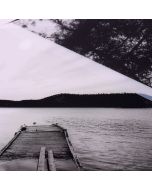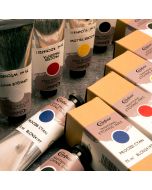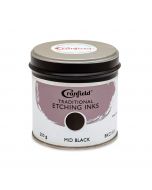These stochastic screens are built by tiny dots that are randomly arranged using digital software. This random arrangement (stochastic) avoids any kind of interference with the positive image. A stochastic aquatint screen is essential to avoid balding and loss in images with tonal graduations on the polymer.
Whether working with analogue positives or digital positives, it is essential to use a stochastic screen. The aquatint screen is the necessary tool to structure the plate and make the reproduction of continuous tone images feasible. The random and microscopic arrangement of the stochastic plot points helps us to take advantage of all those grays that would not appear otherwise.
In the jargon of engravers it is known as aquatint screen by analogy to the chalcographic technique, where random dots of resin are arranged on metal plates, accommodating the base for the construction of tonal images depending the acid action. In our case, the aquatint screen is exposed on the polymer plates before the image positive.
Our stochastic screens are digitally processed to simulate an irregular arrangement of the points, simulating the stochastic FM options offered by the filming machines softwares. In this way we can have control over the percentage of opacity, the layout and size of the point. Rittagraf has created a series of frames expressly for photo-engraving with polymer plates. This does not mean that it cannot be used in another technique but, after all, they have been used for use with photopolymer.
Due to the demand of some clients, the Rittagraf team has generated 3 different types of frames. The three differ in the size of the plot point.
- Heavy Dot Screen: 84 micron size dot
- Medium Dot Screen: 40 micron size dot
- Fine Dot Screen: 31 micron size dot
The screen greatly affects the final quality of our photopolymer plate. The tonal range that we can achieve in photogravure printing depends on the structure and layout of the plot. Without the use of a stochastic screen, our photo-etchings prints would be too contrasty, missing out on the wide tonal ranges that can be achieved with polymer. To learn more about the use and of this type of patterns in photopolymer plates, we recommend the most complete study and book of photogravure by our friend Ramón Freire: The graphic act as construction. Autographic positive and photopolymer plate (spanish language). Among others, we also recommend you: Polymer Photogravure, A new Method for Photographers and Graphic Artists, from Taneli Eskola and Kari Holopainen.










